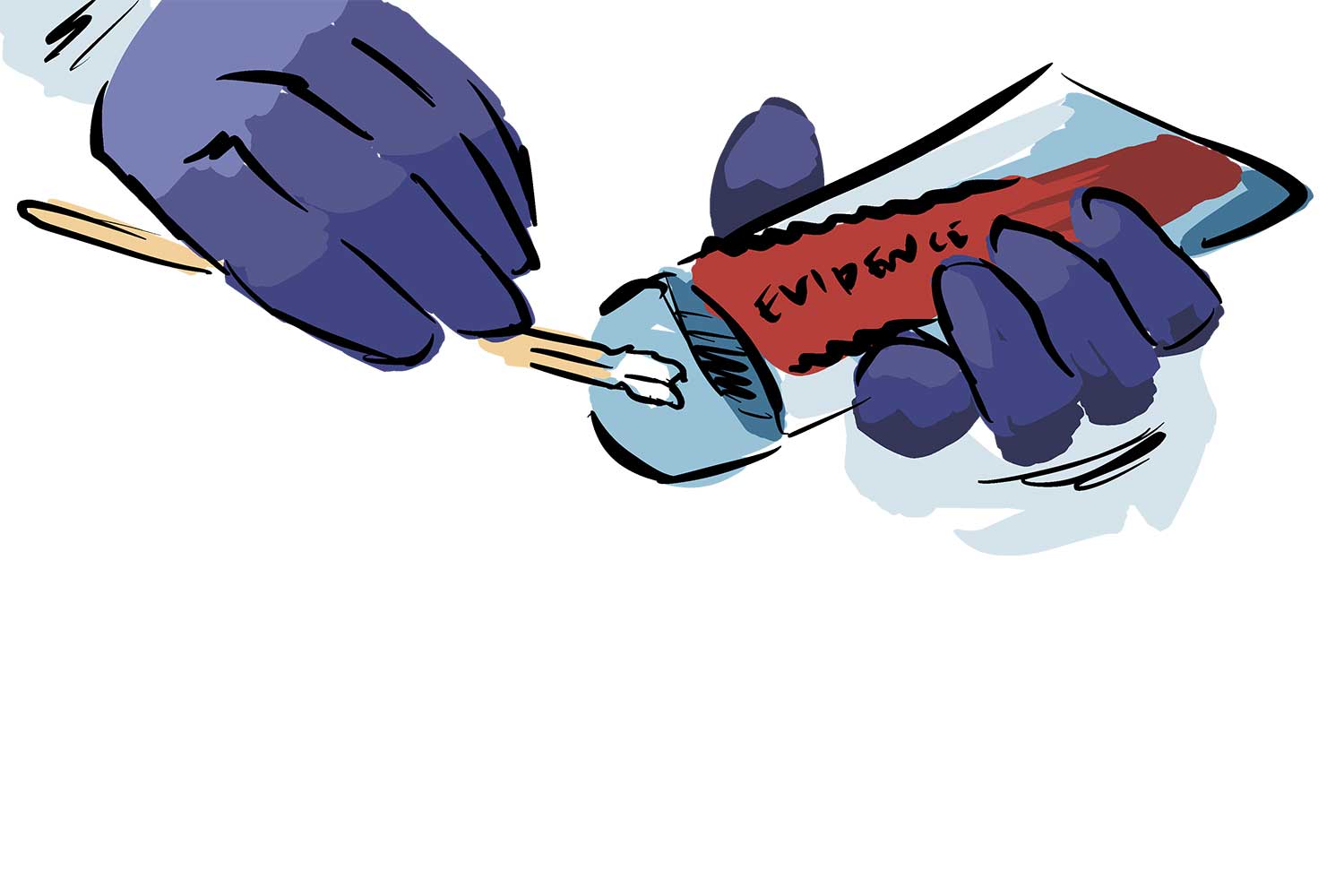When sexual assault victims walk into a hospital, they check in at the front desk — and the waiting begins.
They wait for their blood to be collected, for almost every orifice in their body to be swabbed, for their hair to be combed and gathered, and for their bruises to be inspected in what proves to be an extensive medical exam and evidence collection process.
But victims walking into some Eugene-Springfield hospitals often wait for hours in the chaos of the emergency room, reliving their trauma before a nurse is available to do the exam.
These sexual assault survivors are not getting the medical care they deserve because of the way hospital staffing and resources are used. They can end up waiting for hours in an emergency room before they are even examined by a sexual assault nurse examiner (SANE).
Most of these nurses are not qualified to examine kids, who then have even fewer options.
Because of the long waits, adults and children are sometimes transferred to hospitals as far away as Albany, where a clinic called Sarah’s Place provides a vastly different experience and offers 24/7 care.
And some, who understandably cannot handle the wait or a transfer, go home unexamined.
Growing Need
In looking for more information on this, Eugene Weekly reached out to local PeaceHealth Medical Group hospitals with some questions:
What are the average wait times for a sexual assault survivor to be examined? How often are victims transferred to Sarah’s Place in Albany or other hospitals? And is PeaceHealth taking any steps to better care of victims?
In response, PeaceHealth declined to answer any direct questions or to provide records, instead offering a couple of statements sent by local communications specialist Sherri Buri McDonald.
“At PeaceHealth, patients are at the center of all we do,” McDonald writes in an email. “If we cannot provide care safely and in a timely manner, then we always take a course of action that is in the patient’s best interest.”
Emergency Department director Ruth Franke also declined to speak and instead referred to the statement issued by PeaceHealth.
EW also reached out to McKenzie-Willamette Medical Center in Springfield and spoke with the director of the Emergency Services and Trauma Program, Valerie Simmons. Although McKenzie-Willamette is smaller, Simmons says the hospital wants to have full coverage for sexual assault victims at all times.
She adds that they have been trying to partner with PeaceHealth Sacred Heart Medical Center at RiverBend to provide full coverage, but that effort has “gone to the wayside.” Simmons says she isn’t sure why.
Meanwhile, Lane County’s local advocacy group Sexual Assault Support Services (SASS) is getting more calls each year from hospitals reporting sexual assault. SASS is called whenever a patient presents signs of sexual assault — whether that’s during an exam or when they check into the hospital. Then, someone for SASS will assist the victim throughout the process.
According to the data collected by SASS and analyzed by EW, calls to SASS in Lane County have increased 58 percent since 2015.
BB Beltran, executive director of SASS and a member of Lane County Sexual Assault Response Team (SART), says the stats don’t tell the entire story because advocates are not always called, as they should be under county protocols and an Oregon state law, ORS 147.404, passed in 2017.
“That means there are, more likely, more survivors presenting indicating sexual assault than our stats would indicate,” Beltran says. “This shows that hospital staff are not always abiding by our SART protocols.”
Lane County District Attorney Patty Perlow says the county has also seen increased numbers in reporting sexual assault. There has been a 38 percent increase in sex crimes since 2018.
Higher numbers do not necessarily mean more assault, but the advocates say it most likely is a result from the national conversation around sexual assault.
If more people are reporting assault and not enough help is available, some people may never be examined.
Enlarge

Illustration by Chelsea Lovejoy
A Long Wait
PeaceHealth hospitals in the Eugene-Springfield area share 15 SANE nurses who have either completed their 30-hour training or are in the process of it, McDonald says.
McKenzie Willamette has three SANE nurses, and are working training more, Simmons says.
Only certified SANE nurses can perform exams and collect evidence from survivors.
If no SANE nurses are available to conduct exams, a victim has several options. They might be transferred to another hospital, or they might be told to wait until an on-call nurse volunteers to come in, or they might choose to go to Sarah’s Place in Albany.
And, although it is not uncommon, the experts with SART say it shouldn’t be happening because Eugene and Springfield are “resource rich” areas.
“It’s a burden on a survivor, it’s a burden on resources and it’s a burden on Albany,” Beltran says.
Many victims will choose to check into the emergency room and wait.
But, for some, that wait is too long. And they leave.
According to data collected by ProPublica, a nonprofit specializing in data and investigative journalism, PeaceHealth’s RiverBend hospital’s average wait time for any emergency room patient is three hours and 23 minutes before someone is sent home if they are not admitted. For PeaceHealth’s University District hospital, the average wait is around two hours and 16 minutes, and at McKenzie-Willamette the wait is about two hours and 34 minutes. For survivors, this wait may be even longer depending on SANE nurse availability.
Because PeaceHealth declined to answer any public records requests, EW was unable to find the specific wait times for sexual assault survivors before they are examined by a SANE.
These wait times are even more crucial when it comes to sexual assault victims because evidence could be compromised.
In order to ensure the SANE exam and evidence collection process is accurate, victims are asked to withhold certain bodily functions, such as using the restroom or drinking water, says Katie Green, a prosecutor for the District Attorney’s Office.
“It’s just inhumane,” Green says. “If you’ve ever sat in an emergency room, you know how chaotic it can be.”
Green adds that there are many barriers to navigate in coming to a hospital to report a sexual assault. She says she can imagine when people feel there is a barrier at the medical level — such as a long wait or drive — they may not choose to report the assault: “They might turn away and say, ‘Never mind,’” Green says.
This can also be dangerous for external injuries such as strangulation or bruising. If survivors of sexual violence choose to go home, they will not receive medical care for their injuries. Accessing emergency contraceptives and medication to prevent sexually transmitted diseases are also involved in the exam process.
“Evidence collection is a byproduct, but they are still not getting that basic medical care,” Beltran says.
This issue is also made more complex when a child is involved, says Sarah Stewart, executive director of Kids FIRST, a child advocacy center.
Green recalls a time when a child came forward about a sexual assault at 2 am. Law enforcement planned to take the child to RiverBend but found out the hospital wouldn’t be able to have a SANE nurse come in until 11 am — the next morning.
Green says when she explained the situation to RiverBend and mentioned the child, RiverBend said it couldn’t see the child anyway because its SANE nurses aren’t certified to examine children. The child was taken to Sarah’s Place.
“The challenge that we have is, even if there is a SANE available, they are unable to collect evidence. So they go to Sarah’s Place,” she says. “The pediatric SANE problem is statewide,” she adds. “Not just Lane County.”
Beltran says that for a survivor of sexual trauma, the wait can sow more distrust between the survivor and other people.
“The system works the way it does, and you don’t find out about it until you need it. I mean that’s a betrayal for sure,” Beltran says. “Your expectation when you go to an emergency room is that you are seen as promptly as possible.”
When SASS is called to send an advocate for an assault victim, Beltran says sometimes SASS arrives to find the survivor has left. Advocates working with SASS are on a small staff and budget, she says, so they cannot sit with a survivor for seven hours while they wait for a nurse to come perform a SANE exam.
“Usually the survivor is pretty tired at this point, so they might go home. We don’t know if every survivor receives medical care,” she says.
Sarah’s Place
With a calm atmosphere and a SANE nurse available at all times, Samaritan Hospital’s clinic Sarah’s Place stands apart as the gold standard for care of sexual violence survivors.
The entrance to Sarah’s Place is locked for security. To get in, someone first has to ring the doorbell.
Once inside, survivors trade sterile, white hospital walls for soft grey ones. The facility has two consulting rooms that feel more like a living room than a clinic room, giving the victim a safe place to discuss their story with a SANE nurse.
Outside of the room is a blanket-warming machine, and the hall cupboards have extra clothes and toys for kids.
Another calming feature of Sarah’s Place is the light gray bathroom in the corner. With gentle decor, charcoal-colored embroidered towels and a floral shower curtain, the bathroom mimics one you might find in a home.
Sarah’s Place is based in Albany General Hospital and run by the Samaritan Health Services. It operates to provide exams and help for survivors of sexual assault. Sarah’s Place offers 24/7 care with a SANE nurse at the clinic all day, and someone on call at night.
When Sarah’s Place SANE nurses are not helping patients, they spend most of their time on community outreach by educating fire departments, schools, churches and law enforcement on sexual assault resources available.
“When we are not seeing patients, we have this wonderful opportunity to educate and serve the community for prevention and getting the word out that we are here for you,” says Amie Keys, a SANE nurse with Sarah’s Place.
Keys says all the Samaritan hospitals in Linn, Benton and Lincoln counties use Sarah’s Place. Linn-Benton’s local advocacy group, CARDV, and law enforcement will bring patients in. Some survivors drive themselves, and Sarah’s Place also provides taxi vouchers.
This clinic is also the only place in the Pacific Northwest that offers a clinic that is separate from the ER with around the clock care, she says.
Patti Kenyon helped start Sarah’s Place in 2016. She has more than 40 years of experience caring for sexual assault patients, and now works for the Oregon Sexual Assault Task Force
Kenyon says Sarah’s Place was created out of a need for around-the-clock services for survivors.
“Like most hospitals in the state, we were all having the same problem of not being able to provide 24/7 care of survivors of sexual assault,” she says.
Kenyon researched the other five Samaritan hospitals in Lincoln, Linn and Benton counties and found that the hospitals were either unable to provide care, or inadequate care was being given.
Then the administration at Samaritan Health Services came together to invest in Sarah’s Place.
“They saw this as providing medical care, emotional care and if the patient would like a kit done, they could have one done,” Kenyon says.
Enlarge

Illustration by Chelsea Lovejoy
No One Available
In local PeaceHealth hospitals, SANE nurses are not always available to do exams right away because they are primarily required to be emergency department nurses. These nurses can choose to complete the 40-hour SANE nurse training, but this often competes with their other scheduling demands.
Green says there used to be a shortage of SANEs, but the problem has shifted so that it is no longer the number of nurses but how and when they are available to do exams.
In an email statement to EW, PeaceHealth communications specialist McDonald wrote that every day, certified SANE nurses work primarily in the Emergency Department.
“As a back-up, PeaceHealth also has a voluntary on-call schedule of nurses with SANE training,” McDonald said.
For some SANE nurses, though, this isn’t enough.
Mary Ann Vaughn has been a SANE nurse for 30 years, and she says she wishes it was her sole job. But, due to the structure of the hospital, she works full time in the Emergency Department as a nurse and part time as a SANE nurse.
“They don’t have dedicated SANE nurses. It’s always been that you were an ER nurse,” Vaughn says.
In her experience, when someone comes to be examined for sexual assault and no certified SANE nurse is at the hospital, PeaceHealth will ask the SANE nurses on call.
Some days no nurse is available.
“Maybe no one is available,” Vaughn says. “Women wait. Men wait.”
And, if no one is available right away, some victims go home, she says.
“Do people ever go home? Oh, I know they do,” she says. “I’ve had it happen to me. They go home after a long wait.”
At McKenzie-Willamette, each nurse signs up for an on-call shift, and ER director Simmons says that they should arrive at the hospital within 30 minutes of a victim arriving at the hospital.
“We also make sure all the staff understands what to do when a victim comes in and what their role is to provide care,” Simmons says.
Creating a separate clinic like Sarah’s Place for sexual assault victims benefits not only the survivors and SANE nurses, Kenyon says, but also allows emergency rooms to function at a higher level.
She adds that for each medical community the needs are different. “There are many different models and this was the one we chose,” she says.
Sarah’s Place originally received funding from a grant for the remodeling of the space, and is now funded through donations, events and from The Albany General Hospital Foundation System. Kenyon adds the clinic is not a moneymaker.
Because of its success in providing care to survivors, Kenyon says each Good Samaritan Medical Center wanted to have its own Sarah’s Place, instead of driving across counties to Albany. This can cause difficulties when people don’t have a way to get there.
For survivors in Lane County, Sarah’s Place is about 45 miles out of the way, and Lane County sexual assault advocates say people shouldn’t have to go that far to get care for sexual assault.
“They are doing fine, but at what cost?” Stewart says. “A 13-year-old driving in the back of a cop car all the way to Albany? Someone driving an hour at night after they’ve been sexually assaulted?”
Changing the System
According to SART members, PeaceHealth hospitals have several general options for how they can improve care of survivors.
The minimum step they can take, Perlow says, would be to create a better on-call schedule with nurses, so that someone will be available at all times.
PeaceHealth hospitals are also working on a contract with Rapid Save Investigation (RSI), a SANE nurse agency that contracts with hospitals to aid them in having full care. This would provide a 24/7 on-call SANE nurse. Because the contract is in process, RSI could not give more details at the time of this story.
But the ideal solution, advocates say, would be for the hospital to create a clinic similar to Sarah’s Place, where survivors can go and get care right away in a non-emergency room facility.
“I think that the gold standard right now is in Albany. Their response is pretty incredible and what we are hoping this community would have,” Beltran says, adding that this is a statewide issue, though with local resources, Lane County hospitals can do better.
For now, survivors are not always getting the adequate care they need after experiencing a sexual trauma.
Medical care and support for sexual assault survivors need to be prioritized, Perlow says.
“Our community should be providing medical care for the people who need it.” ν
